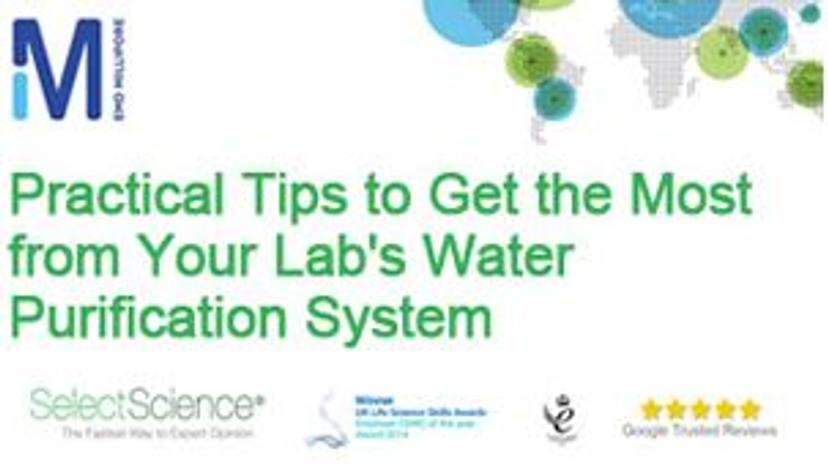Webinar Highlights: Practical Tips to Get the Most from Your Lab Water Purification System
20 May 2015

Water is the most commonly used solvent in laboratories, yet it is probably the least understood. In this webinar, Dr. Estelle Riché, of the Lab Water Application Group, Millipore SAS, shares practical tips on how you can get the most out of your water purification system.
Learn how to optimize the use of your water purification system and how proper handling of ultrapure water will help to boost your productivity. Plus, discover how to identify potential sources of water contamination, and understand how these contaminants may affect experimental results.
Watch the on-demand webinar here, read on for highlights from the webinar Q&A session, or download the associated article and application notes.
1. Are the distillators used in some labs efficient for the purification of water?
Distillation is the historical way of purifying water. It works by evaporating water and condensing the vapor. Using this method, only pure water is collected and bacteria, particles and other contaminants stay in the container. It is a good technique but it has limitations. One problem is that it is a slow technique and in some cases the distilled water may be re-contaminated by the collection vessel or the air of the lab. Another problem is that there may be a few molecules that distil with the water and will not be removed. The quality of the water is also not known and there is no way to monitor its quality. In addition, distillators can be difficult to clean, especially if you are in a hard water area. Distilled water is classified as pure water but, it is not ultrapure water and should not be compared to ultrapure water.
2. Can the Elix® system produce 18.2 MΩ.cm water?
No, it is a pre-treatment system so it delivers water with a resistivity above 5 MΩ.cm, but not ultrapure water. However, if you want 18.2 MΩ.cm water you would need an additional polishing system such as the Milli-Q® Advantage A10 Laboratory Water Purification System.
3. As you mentioned, it is not advisable to store ultrapure water. Is it ok to keep the water in the tank of the water system until its usage and what is the maximum time to store in the tank?
On most systems there is a tank to collect the pure water after the pre-treatment, this is required because pre-treatment is a relatively slow process and it is important to accumulate pre-treated water to generate ultrapure water with a high flow rate. It is ok to store pre-treated (pure) water but it is not recommended to store ultrapure water. EMD Millipore tanks have features that protect the quality of pure water during storage. Our tanks are opaque so there is no risk of algae growing inside the tank. There is a vent filter which protects the tank from airborne contaminants when you draw water. A UV lamp may also be placed inside the tank to protect from bacteria growth. If you have all of these features you can store the water in a tank for a while, but in a regular plastic container I wouldn’t keep it for more than a few days. It really depends on the sensitivity of your analyses.
4. I tried to measure the pH of my water, but I obtained a strange result, it wasn’t pH 7; do you have any ideas why?
If it was ultrapure water there were not enough ions in the water to enable the pH meter/paper to work properly. Your pH meter might give you some erratic values and you could even damage the electrode. If you have any ions that affect pH in the water, the resistivity will change and will no longer be 18.2 MΩ.cm. If the resistivity is at 18.2 MΩ.cm then you don’t have to measure the pH since you can safely assume that it is 7 since no ions (other than OH- and H3O+) are present. Be aware, however, that after a few minutes, some carbon dioxide from the air will dissolve into the ultrapure water and make it slightly acidic, this is a normal process.
5. At what water resistivity and TOC is it unacceptable to use the system?
It depends on the sensitivity of your application. If it is ultrapure water, the resistivity should be 18.2 MΩ.cm, if it is not then there may be something wrong with your system and you should investigate. It’s the same for TOC: we consider that water is ultrapure if it is at or below 5 ppb of TOC. If the TOC from your water system is 50 ppb or 100 ppb, again, something is wrong with your system.
6. For how long can you store water for HPLC applications?
I would recommend that you get freshly purified ultrapure water every morning and change it daily, if possible. If you have to store your water, as you don’t have regular access to a water purification system, and depending on the sensitivity of your technique, you could perhaps store water for up to a maximum of one week. I would recommend you test the water for your own technique. It is also important that you use a special protective cap to protect the water from the air of the lab, which may contaminate it.
For more information and to get the most from your laboratory water, read these articles and application notes:
10 Ways to Improve Your Lab's Water Quality
High Purity Water: Hints and Tips
Choosing the optimal high purity water source for ICP-MS
Optimizing the Use of High Purity Water in Ion Chromatography
Tips and Tricks for Handling High Purity Water in the LC-MS Laboratory
